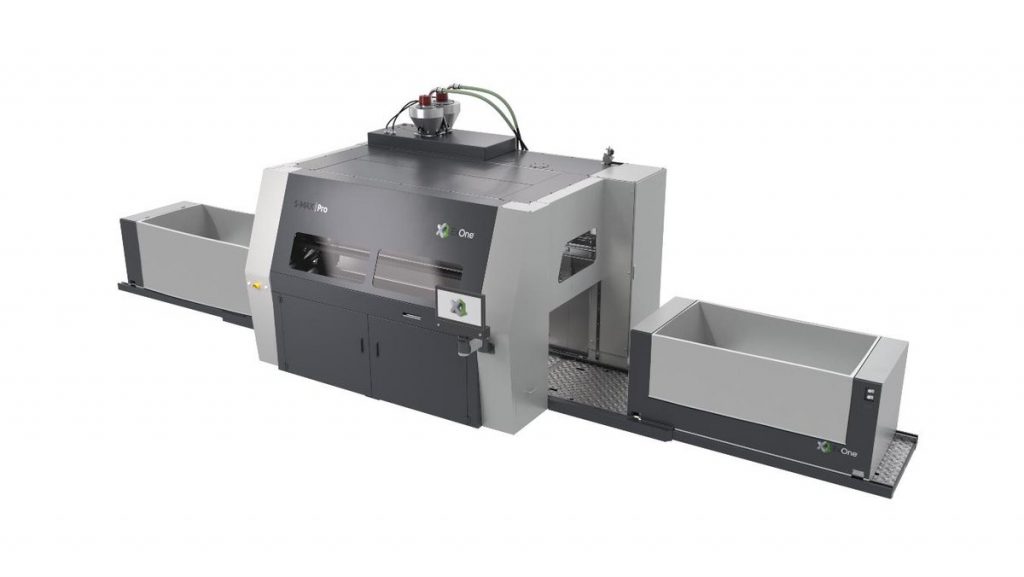US-based tooling and mold-making firm Versevo has added an ExOne S-Max Pro binder jet 3D sand printer to its technology portfolio.
The S-Max Pro will allow Versevo to produce early development, low volume, and production sand cores faster and more economically than with conventional sand core blowing methods.
With the 3D sand printer, the company will be able to consolidate complex cores into single components, eliminating costly assembly operations. This also reduces manual labor requirements and limits the potential for process-related defects.
“This process lowers costs for customers because the automated system eliminates the need for labor, reduces scrap, and is printed directly from 3D CAD data, therefore eliminating the need for physical tooling and core assembly operations,” explained Versevo’s CEO and President Terry Moon.
Versevo claims that its new 3D sand printing technology will allow it to scale its production capabilities, and meet growing customer demand.

Versevo adopts 3D sand printing
Founded back in 1994, Versevo produces molds, tooling, and metal casts for customers in industries including agriculture, construction, mining, and machinery manufacturing.
The company’s new S-Max Pro can 3D print at speeds of up to 135 liters per hour, which translates to 18 seconds for each layer. With a substantial build volume of 1260-liter (44 Cu Ft), the 3D printer can achieve layer heights ranging from 0.2mm (.008”) to 0.5 mm (.020”). What’s more, it can reportedly produce two 1,800 x 1,000 x 700 (mm) job boxes in the space of 24 hours.
Introduced at the 2019 GIFA International Foundry Trade Fair, the S-Max Pro also features an automated recoater and a printhead designed to optimize efficiency. The 3D printer has also been designed to support 24/7 operation, incorporating inline processing and machine monitoring. This feature can detect and automatically correct any 3D printing errors.
According to Versevo, 3D sand printing allows iterative designs to be changed quickly and easily. This is key for metal casters and OEMs producing aluminum castings with complex shapes. Indeed, with the S-Max Pro, Versevo can 3D print molds and cores in a matter of days. Alternatively, it can take weeks or months to physically modify traditional hard tooling.
“3D Sand printing allows us to deliver molds and cores faster using the same raw materials and chemicals as is used in current production core making processes,” added Moon.
The Wisconsin-based company’s new additive manufacturing technology will enable it to quickly produce high-value parts for customers in the automotive, aerospace, military, marine, recreational, and heavy truck sectors.

3D printing enhances metal casting
Over recent years, 3D printing has witnessed a growing role in the production of cores and molds for metal casting applications
In 2020, ExOne launched the Sand 3D Printing Network. Powered by over 40 industrial binder jet 3D printers, the network seeks to make 3D printed molds and cores more accessible to manufacturers in North America.
The network leverages a fleet of the company’s ExOne’s S-Max and S-Print additive manufacturing systems. These industrial binder jet 3D printers are located at premium pattern shops and foundries throughout the United States, Canada, and Mexico. Molds and cores ordered through the network are usually delivered in 3-5 days.
Elsewhere, New Zealand-based metal casting start-up Foundry Lab offers its microwave Digital Metal Casting (DMC), which enables the same-day turnaround of metal castings. The company’s plugin for Fusion 360 automates mold designs from CAD files. These designs are then fabricated with a binder jet 3D printer, which lays down layers of ceramic powder and binder.
The DMC’s microwave system heats the powder to set the binder. The microwave also melts metal within the molds, which ensures an even casting. A quench system then rapidly cools the casts.
Speaking at the 2024 AMUG Conference, the company’s founder David Moodie highlighted that DMC significantly reduces the time and cost associated with metal casting. He called the approach “casting for dummies,” emphasizing that the method is simple and accessible. The technology is also compatible with various metals, with temperatures ranging from 1,100 degrees Celsius to 2,000 Fahrenheit.
Want to help select the winners of the 2024 3D Printing Industry Awards? Join the Expert Committee today.
What does the future of 3D printing hold?
What near-term 3D printing trends have been highlighted by industry experts?
Subscribe to the 3D Printing Industry newsletter to keep up to date with the latest 3D printing news.
You can also follow us on Twitter, like our Facebook page, and subscribe to the 3D Printing Industry Youtube channel to access more exclusive content.
Featured image shows the ExOne S-Max Pro. Image via ExOne.

